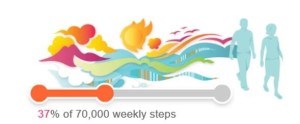
Inspiration from a wrist band?
As someone who has partnered with tech and consumer brands for years, I have a bird’s eye view of cutting-edge products and cool gadgets and I love to see when they move from early adoption to widespread acceptance. A product marks an important milestone when it shifts from being covered in the trades to being covered on “Good Morning America.” And it seems like that moment has come for fitness trackers.
Technology Heritage
As an agency with such a strong heritage in the technology industry, we have been there for many of these transitions — personal computers and smartphones were particularly momentous shifts. And wearable tech is shaping up to be the same for current clients and potential clients as well.
I thought it would be interesting for me to do some firsthand research into fitness trackers for that very reason. Which is why I’ve been wearing my navy blue Fitbit off and on for the past few weeks. (For the record, I did get one of these at TED a few years ago, but I might/might not have been waiting for the trendy colors.)
Fitness Tracker Research
A few things I’ve noticed since I’ve started wearing the Fitbit. First, it is very motivating. Setting a goal to take 10,000 steps per day or 70,000 steps in a week quickly set my wheels spinning on how to accomplish it. I paced around during phone calls, parked further away and suggested walking meetings. Of course there was already a Fitbit group at WE, and that community welcomed me in and were the first to sign up for my walking one-on-one meetings. All this effort paid off: In my first few weeks, I’m averaging 13,799 steps per day, hitting my goal with steps to spare. The Fitbit is also a great reminder of fitness. I am more conscious about my health choices every time I look at my wrist.

However, I’m not yet in the habit of wearing it. I left it behind when I traveled recently, forgetting to add it to my packing list. Then, I took three short day hikes averaging six miles each without it and actually had a moment of irritation that I didn’t get “credit” for it (good grief). And synching it up with my phone is another habit that I need to form. The little screen on the Fitbit doesn’t give me much information.
It also keeps asking me if I want to track my sleep. Well, no because I’d turn in dismal records especially measured against Arianna Huffington’s sleep recommendation. I’m trying Arianna, I really am, but for now it’s better to stay focused on motion-based activities.
I’m certainly a fan and have really enjoyed the interactions with the Fitbit community. I’m looking forward to attempting more group meetings while walking. However, I am, as usual, interested in what comes next. New research indicates that people only expect wearable tech to grow in adoption. How can the data it provides be integrated into a larger picture our overall health? Will we give our doctors access to it? And will they make recommendations based on that data? And will trackers get better to factor in weight loss, blood pressure and other health indicators? Experts say we aren’t far away from noninvasive blood chemistry sensors.
And what happens when the trackers become push rather than pull, and I start getting text messages that I need to take 1,000 more steps to hit my goal? Or to get to sleep. This is another reason I don’t think I’ll set up the sleep tracking, at least for now.
All this means that I think we are only at the beginning of what these trackers can do. And in the meantime if you want to talk, be sure to bring your walking shoes.
Read more posts from WE Global CEO and Founder Melissa Waggener Zorkin here.
Follow Melissa on LinkedIn and Twitter.
The latest blogs from WE
Decoding Gen Alpha: A Primer on the Next Gen of Consumers
Why Gen Alpha Will Fuel Spending This Season
Why Reputation Is a Business Driver in Healthcare


